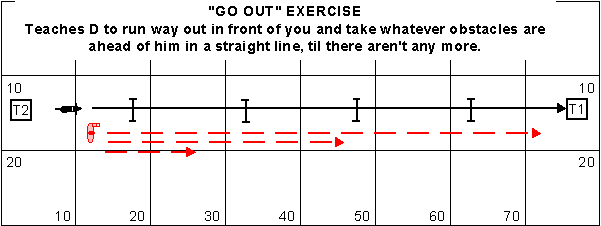"GO OUT" Defined: That's when your dog needs to continue on in a straight line over 2 or more obstacles and you can't run fast enough to go along with them. This usually happens at the end of a run, but it can happen in the middle, as it did in the Field 4 exercise.
"G-G-GO" Command: I already have an "OUT" command, which means to veer out away from me, go around the back side of a jump, or take an obstacle that's out there. Not wanting to confuse D, I decided on "G-G-GO" as my command instead of "GO OUT". I already use GO to mean "run fast, keep going over the dog walk or see saw or thru the weaves", and since those both involve straight forward momentum and me lagging behind, I think GO can be broadened to mean, "go forward in a straight line". I add a few G's, as in G-G-Go, to distinguish GO from the one syllable NO command.
Here's a link to a Susan Garrett YouTube video at 2011 World Agility Championships that beautifully illustrates the Go-Go-Go command. This is very important in competition, when speed counts.
The diagram below shows how we trained our "go outs". It was a neat exercise and made Maxie, Charlie and Lucky run very fast. Maxie especially, ran like a bullet! They caught on quickly.
Here's how it works:
H takes D toT1, places a treat on the target where D can see it (on an upside down flower pot, something very visible from a distance), says "Leave It", then walks D to other end, sits D, then runs along side, arm closest to D pointing forward, as D takes each jump in turn all the way to T1. "Over, over, over, over, get it."
Repeat, H running alongside D but stopping around 3rd jump and saying "Over, over, over, GO, get it". When D is successful heading straight for T1 without H running alongside the whole way, H can lag a few feet further behind at each turn until finally, H can stop forward mementum after 1st jump, saying "Over, G-G-GO". D quickly understands that GO means "take the rest of the jumps ahead". No need for H to say Jump, Hup, or Over for each jump.
As D catches on, H can also place a treat at T2 before D takes off for T1, then after treat is eaten at T1, H can call D back across jumps towards T2, saying "Over, HERE".
This kind of relay race can go on, back and forth, several times. Eventually, fade to less and less visible targets (smaller flower pots), a flat tile, intermittent treats placed on the target, then no target at all. Eventually you can reward a successful GO OUT by treating from your hand when D circles back to you. If you have a partner stationed at each end, each one can lay out the next treat on the flower pot, take turns sending and calling their own dog, over and over.
For toy motivated D, you can substitute the target with a ball, but you have to be able to throw it far and straight. This is very difficult and not recommended.
Variations: Use 3 to 5 jumps, closer or further apart, different kinds of jumps, a straight tunnel, chute, see saw. The only constant is they must be in a straight line, and everything in D's path must be taken all the way to the end.
Caution: In training, don't ever call D off of a GO OUT command, or it won't mean GO OUT any more. Only after they have committed to the last obstacle in the straight-line sequence should you call them off towards you or another obstacle. Here's a training quote from Jane Simmons-Moake's Sequence Training book:
"When I do (or say) this, you do that".
Straightforward. Simple. Easy to remember. I like that.
If you want to play call-offs, another good game, don't say GO.
If you want to play call-offs, another good game, don't say GO.


No comments:
Post a Comment